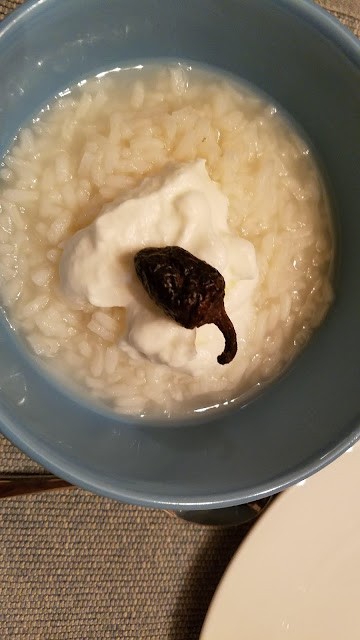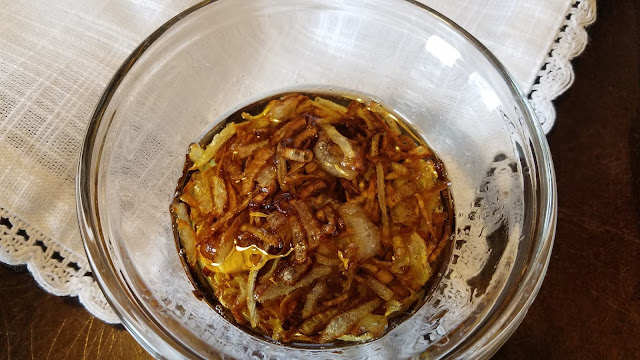 |
| kaayayum irachiyumittu vechathu |
Another Nazrani staple, especially among Trichurians -
Thrissurkkaar, is this dish that I am going to serve now. Traditionally served with "kanji" which is rice with the water in which it is cooked, this dish is also interesting with rice, and yogurt. :)
Now I learn that our "kanji" is the same as the Chinese "congee"! curioser and curioser! to learn that in spite of all the differences, we are so similar. anyway, the kanji made out of traditional Kerala rice is superior to the one made out of the parboiled substitute that I buy here. Kerala rice is brown-streaked, and plump. It is rich in thiamine. And add to that melted ghee sauteed with pearl onions! it is ambrosia. Mallus have a ball with kanji -- we have
paalkanji, which is milk added to kanji, the above mentioned ghee kanji etc etc. We eat kanji with hot pickles, papadams, and vegetable stirfrys/
mezhukkupurattis and of course, the payaru curry -- the red bean lentil curry, as a breakfast dish --
kanjiyum payarum. That was during the good old days of farms and farming. A healthy boost of protein in the morning, before they went out to the rice fields and coconut plantations.
nazranis eat meat, including beef and pork. And they have this whole lot of stirfry dishes that combines meat and a veggie. Like the present beef and plantain. Then there is beef and tapioca/
kappa, beef and ash gourd/
kumbalanga, beef or pork and
koorkka or Chinese potato and so on. Of all of these, I like the beef-plantain combo. well, it is hard to choose, rather!
For my dad, this dish, by itself, used to be a snack with his whisky. It is great with wine, and black tea or coffee, btw.
About plantains -- naturally, there are varieties of plantains. The one I use here must be from South America. Kerala has a lot of different varieties of plantain too, the "naadan"/country "nenthrakkaya", as we Thrissurkkar call it, or "aethakka" , as the Southern Keralites call it, being the favorite. While green, they are used to make chips -- glazed and plain, and stirfries, and other dishes and when ripe, they have a whole different culinary uses. The peel of the organically grown green plantain is full of nutrients, and is used by itself, in stirfries. So are the banana flowers.
Ingredients:
1. Beef, boneless, cubed - 2 lb
plantain -- 1 large, green, cubed
onion - 1/2 cup sliced
green chilli peppers - 5, slit
ginger, crushed - 2 tbsp
curry leaves -- 1 sprig
Oil - 3 tbsp
2. whole coriander seeds - 3 tsp
whole fennel seeds - 1/4 tsp
whole dried red chili peppers - 7
black peppercorns - 3 tsp
for final seasoning:
onion - 1/2 cup, sliced
4 garlic cloves, crushed
1/2 tsp crushed red chili powder
1/2 tsp kerala meat masala powder
curry leaves, 1 sprig
Oil
Salt
Method:
Prepare the meat, and the plantain.
Remove the peel of the plantain along the ridges. Cut the plantain in cubes, and soak it in water with a pinch of turmeric. Keep for a few minutes. Wash and drain. Cook the plantain in some water. Set aside.
Fry the spices in the second set in a slightly greased skillet, for 3 minutes.
Crush these into powder.
Mix the onion, green chillies, ginger, and the spice-mix and salt in the oil.
Add the meat to this and mix well.
Cook the meat covered, with water to cover the meat. High heat till it comes to a boil.
Then reduce heat, and let simmer. Keep the lid on.
Stir occasionally. Cook till dry. Add the plantain to this. Mix well.
Now the seasoning.
Heat oil in a wok or skillet. Add onion, garlic, curry leaves. Stir well. Fry till onions turn soft and the garlic turns a very light brown. Add the spices.
Fry for a minute.
Now, add the beef-plantain mixture. Toss well. Let it heat through, without burning.
ps: Some, like my mom, cook the plantain along with the meat, before the final seasoning. She adds the plantain when the meat is almost done. Timing becomes important then, because if you are not careful, you may end up with a watery mush. That is rather nerve racking for me -- this way, I have more control over the whole procedure.
Serve with kanji, pickles and ghee (with sauteed baby onions), or rice and yogurt.





















